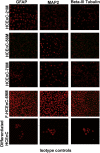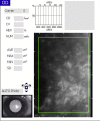Existence of Neural Crest-Derived Progenitor Cells in Normal and Fuchs Endothelial Dystrophy Corneal Endothelium
- PMID: 27639969
- PMCID: PMC5222986
- DOI: 10.1016/j.ajpath.2016.06.011
Existence of Neural Crest-Derived Progenitor Cells in Normal and Fuchs Endothelial Dystrophy Corneal Endothelium
Abstract
Human corneal endothelial cells are derived from neural crest and because of postmitotic arrest lack competence to repair cell loss from trauma, aging, and degenerative disorders such as Fuchs endothelial corneal dystrophy (FECD). Herein, we identified a rapidly proliferating subpopulation of cells from the corneal endothelium of adult normal and FECD donors that exhibited features of neural crest-derived progenitor (NCDP) cells by showing absence of senescence with passaging, propensity to form spheres, and increased colony forming efficacy compared with the primary cells. The collective expression of stem cell-related genes SOX2, OCT4, LGR5, TP63 (p63), as well as neural crest marker genes PSIP1 (p75(NTR)), PAX3, SOX9, AP2B1 (AP-2β), and NES, generated a phenotypic footprint of endothelial NCDPs. NCDPs displayed multipotency by differentiating into microtubule-associated protein 2, β-III tubulin, and glial fibrillary acidic protein positive neurons and into p75(NTR)-positive human corneal endothelial cells that exhibited transendothelial resistance of functional endothelium. In conclusion, we found that mitotically incompetent ocular tissue cells contain adult NCDPs that exhibit a profile of transcription factors regulating multipotency and neural crest progenitor characteristics. Identification of normal NCDPs in FECD-affected endothelium holds promise for potential autologous cell therapies.
Copyright © 2016 American Society for Investigative Pathology. Published by Elsevier Inc. All rights reserved.
Figures










Similar articles
-
Function-Related Protein Expression in Fuchs Endothelial Corneal Dystrophy Cells and Tissue Models.Am J Pathol. 2018 Jul;188(7):1703-1712. doi: 10.1016/j.ajpath.2018.03.014. Epub 2018 Apr 24. Am J Pathol. 2018. PMID: 29698634
-
Advanced glycation end products and receptors in Fuchs' dystrophy corneas undergoing Descemet's stripping with endothelial keratoplasty.Ophthalmology. 2007 Aug;114(8):1453-60. doi: 10.1016/j.ophtha.2006.10.049. Epub 2007 Feb 22. Ophthalmology. 2007. PMID: 17320180
-
Endothelial cell microRNA expression in human late-onset Fuchs' dystrophy.Invest Ophthalmol Vis Sci. 2014 Jan 9;55(1):216-25. doi: 10.1167/iovs.13-12689. Invest Ophthalmol Vis Sci. 2014. PMID: 24334445 Free PMC article.
-
Transcript profile of cellular senescence-related genes in Fuchs endothelial corneal dystrophy.Exp Eye Res. 2014 Dec;129:13-7. doi: 10.1016/j.exer.2014.10.011. Epub 2014 Oct 11. Exp Eye Res. 2014. PMID: 25311168 Free PMC article. Review.
-
Mitochondrial Dysfunction and Mitophagy in Fuchs Endothelial Corneal Dystrophy.Cells. 2021 Jul 26;10(8):1888. doi: 10.3390/cells10081888. Cells. 2021. PMID: 34440658 Free PMC article. Review.
Cited by
-
Increased Corneal Endothelial Cell Migration in Fuchs Endothelial Corneal Dystrophy: A Live Cell Imaging Study.Ophthalmol Sci. 2021 Mar 9;1(1):100006. doi: 10.1016/j.xops.2021.100006. eCollection 2021 Mar. Ophthalmol Sci. 2021. PMID: 36246012 Free PMC article.
-
Characterization of Human Transition Zone Reveals a Putative Progenitor-Enriched Niche of Corneal Endothelium.Cells. 2019 Oct 12;8(10):1244. doi: 10.3390/cells8101244. Cells. 2019. PMID: 31614883 Free PMC article.
-
Regenerative medicine in Fuchs' endothelial corneal dystrophy.Taiwan J Ophthalmol. 2020 Jul 6;11(2):122-131. doi: 10.4103/tjo.tjo_23_20. eCollection 2021 Apr-Jun. Taiwan J Ophthalmol. 2020. PMID: 34295617 Free PMC article. Review.
-
Discovering the Potential of Dental Pulp Stem Cells for Corneal Endothelial Cell Production: A Proof of Concept.Front Bioeng Biotechnol. 2021 Jan 28;9:617724. doi: 10.3389/fbioe.2021.617724. eCollection 2021. Front Bioeng Biotechnol. 2021. PMID: 33585434 Free PMC article.
-
Ex vivo expansion and characterization of human corneal endothelium for transplantation: a review.Stem Cell Res Ther. 2021 Oct 30;12(1):554. doi: 10.1186/s13287-021-02611-3. Stem Cell Res Ther. 2021. PMID: 34717745 Free PMC article. Review.
References
-
- Joyce N.C. Proliferative capacity of the corneal endothelium. Prog Retin Eye Res. 2003;22:359–389. - PubMed
-
- Bourne W.M. Biology of the corneal endothelium in health and disease. Eye (Lond) 2003;17:912–918. - PubMed
-
- Dobbins K.R., Price F.W., Jr., Whitson W.E. Trends in the indications for penetrating keratoplasty in the midwestern United States. Cornea. 2000;19:813–816. - PubMed
-
- Ghosheh F.R., Cremona F.A., Rapuano C.J., Cohen E.J., Ayres B.D., Hammersmith K.M., Raber I.M., Laibson P.R. Trends in penetrating keratoplasty in the United States 1980-2005. Int Ophthalmol. 2008;28:147–153. - PubMed
Publication types
MeSH terms
Substances
Grants and funding
LinkOut - more resources
Full Text Sources
Other Literature Sources
Research Materials

